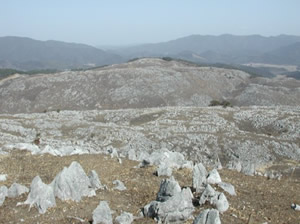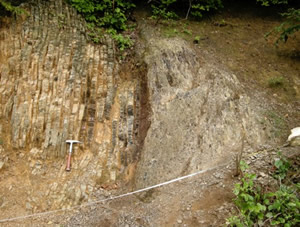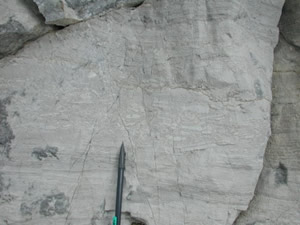
HOME / Departments / Earth and Planetary Sciences / Earth's Geologic Evolution
Earth's Geologic Evolution
-
- ONOUE Tetsuji, Professor
- KIYOKAWA Shoichi, Associate Professor
- MOTOMURA Kento, Assistant Professor
- SATO Honami, Assistant Professor
- The aim of the research of this group is to decipher causes and processes of changes in physical, chemical, and biological features on the Earth over billions of years. We make full use of a good deal of analytical machines and methods, our most fundamental research tool is, however, fieldwork, not only to collect samples, but also to understand geological property of targeted areas and rocks. Also, we need the time axis. It is crucially important to know the timing and tempo of geologic changes and evolution.
Targeted areas are in various parts of the world and range in age from the Archean to the present. Our objectives are mainly varying types of sedimentary rocks and their sequences. Our research is based on the stratigraphy, sedimentology, paleontology, and structural geology as well as the geochemistry and geochronology.
Paleoenvironments of Panthalassic ocean (H. Sano)
Both shallow- and deep-water sediments in the Panthalassa ocean archive most of global environmental and biotic changes during the Late Paleozoic to Mesozoic. As the Panthalassic oceanic sediments had been subducted, only their tectonic fragments/slivers crop out in accretionary complexes in the present circum-Pacific regionas; Japan, Canada, United States, New Zealand etc.
I am a field-base geologist long involved in stsratigraphic, sedimentological, and paleontological researches in several areas in Japan and Canada. The aim of the researches are to read global environmental and biotic changes from the Panthalassic oceanic sediments. Major targets are carbonate rocks both of shallow- and deep-marine facies and siliceous rocks.
Major results include, (1) reconstruction of sedimentary profiles of Late Paleozoic oceanic seamount-associated sediments in Japan (Akiyoshi and Mino) and western Canada (Cache Creek) , emphasizing that sediments on the top, upper slope, and lower flank of a seamount laterally change into each other; (2) estimation of Pennsylvanian to Early Permian (including the culmination of the Phanerozoic-greatest icehouse period) sea-level fluctuation that impacted on sedimentary, diagenetic, and biotic facies in the seamount-top and slope carbonates of the Akiyoshi atoll.


End-Permian mass extinction and Early Triassic environmental and biotic recovery
Causes for the end-Permian biotic crisis and environmental deterioration are a old and new problem in the Earth's history, and have been searched mainly in the shallow shelves of the Tethys ocean and Pangean continental margins. However, as the Panthalassic ocean was the largest open-ocean at the end of the Permian, sedimentological, paleontological, and geochemical data from the Panthallassic ocean could much contribute to the better understanding of the causes and processes of the end-Permian extinction event and protracted environmental and biotic recovery in the Early Triassic.
My colleagues and I reported the lithostratigraphy, sedimentary petrology, biostratigraphy (conodonts and radiolarians), and geochemistry (TOC and δ13C) of the Permian–Triassic boundary sections of deep-marine siliceous rock facies at two localities in the Mino Belt (Jurassic subduction-generated accretionary complex), central Japan. We showed the rapid, pronounced facies change from the Changhsingian radiolarian chert up to the basal Griesbachian highly organic C-rich claystone poor in radiolarians and the sudden extinction of the Late Permian radiolarians at the end of the Permian.

I also examined the P–T boundary section of seamount-top carbonates in the Chichibu Belt, another Jurassic accretionary complex in Japan. The facies analysis revealed the dominance of cyanobacteria and microgastropods in the Griesbachcian section as disaster forms. So far as known, this is the first documentation of the Griesbachian microbialite from the Panthalassic realm. I also have an experience in studying a Spathian carbonate tidal flat facies of Cache Creek Complex in southern British Columbia. The results from southern British Columbia allow me to emphasize that the biodiversity low (only microgastropods, conodonts, and calci-microbes) , but an oxygen-depleted condition nearly disappeared in the carbonate mud-flat at the top of a Panthalassic seamount.